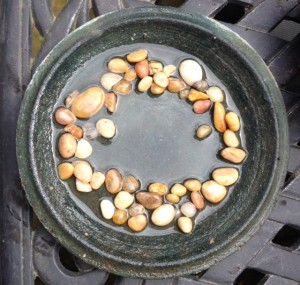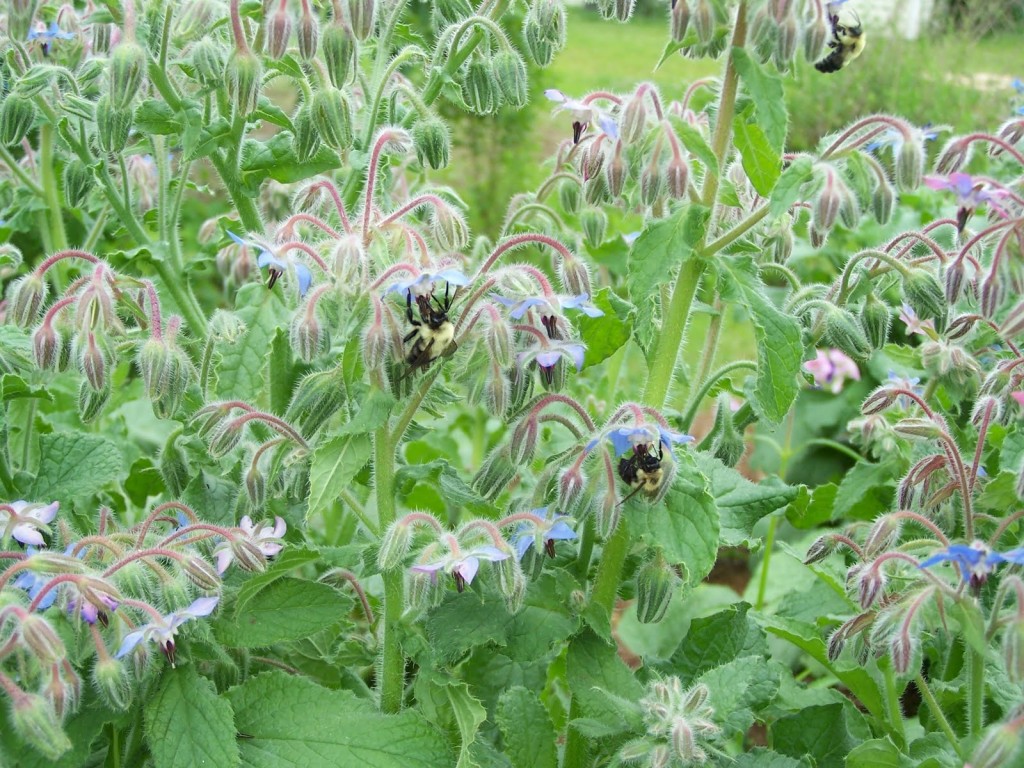Encouraging Bees {courtesy of A. Jonker}
As you may know, bee populations have been under serious threat, due to habitat destruction, pesticide use and natural factors such as fungi infestations. Maple Community Garden established a number of hives of honey bees a few years ago to help increase the populations in our gardening area. These hives are managed by individual members acting as beekeepers responsible for the health and maintenance of the hives. There are also many ways that all garden members can improve and support populations of local bees.
While honeybee and bumblebee populations have been hard hit, other species, of which there are many, can be encouraged to populate and at least partly make up for the decline in numbers. Of particular interest are the species known collectively as “Mason” bees. They take their name from their habit of closing the door to their nest with a layer of mud, as a mason might do. They vary greatly in size and may be unrecognizable as bees. The good news is that, while they are efficient pollinators, they are not aggressive, do not normally bite, and do not swarm, being solitary bees that do not live in colonies. Therefore, you can assist the cause of bee re-population without taking any personal risk!
There are a number of website links at the bottom of this article that include general information applying to all bees, as well as specific information for those interested in creating and managing a solitary bee habitat. Here are some suggestions on how you can help create a better, bee-friendly environment.
Bee Bath
- Place a plate of water at ground level, shallow enough to evaporate over the course of the day. This will help support bees, not mosquitoes.
- Put a few dry rocks and/or flowers in the water for bees to land on, they cannot land on a water surface.
- Placing the plate near infested plants will attract natural predatory insects, which will help reduce unwanted insects, such as aphids.
Bee Food
Bees can use pollen and nectar from a variety of wildflowers. Early bloom, mid-season bloom and late bloom flowers will support them throughout the season. The Maple Community Garden website has a list of bee-friendly plants by season at
http://maplecommunitygarden.ca/projects/beekeeping/
- Use native plants or heirloom varieties
- Bright flowers are preferred (honeybees have very good color vision): blue, purple, violet, white and yellow.
- Plant flowers of a single species in clumps about four feet in diameter instead of in scatterings so bees are more likely to find them.
- Plant a variety of flower shapes as this will benefit a diversity of bees.
- An interesting plant to consider for your bee friendly environment is Himalayan Honeysuckle. It doesn’t need full sunand has some stage of a flower over almost the entire year, so a constant rotation of pollinators go to it.
Habitat (Honeybees and Bumblebees)
Honeybees and bumblebees, being social, require a large productive area to support the colony. Honeybee presence may be indicated by a visible hive, while bumblebee presence may be undetectable as they nest underground or in clumps of vegetation. If you own a large property, or know others that do, such as farmers, encourage owners to leave the edges of fields, lawns or other productive areas empty, wild and undisturbed. This will allow wildflowers to grow in abundance and nests to remain intact year after year.
Habitat (Mason and other solitary bees)
If you would like to experiment with supporting a local solitary bee population, and are not up for building a bee house yourself, you can buy a bee house from a supplier such as Wild Birds Unlimited on West Broadway. They sell manufactured bee houses and nests, as well as bee cocoons. You can also check with your local garden center. Look for these products in December/January prior to the start of the season. Mason bees are active in the spring [March-June], so your bee house/habitat needs to be in place by February-March. Fall and winter management includes cleaning cocoons and cleaning the nests. Mason bee cocoons are vulnerable to predators and parasites and must be stored correctly over the winter as well.
Before purchasing or making a homemade bee habitat, please review the sites below for general information on bees and also for additional information on creating and maintaining a successful solitary bee habitat.
Further Information:
The City of Vancouver http://vancouver.ca/home-property-development/support-bees-and-butterflies.aspx
The David Suzuki Foundation http://www.davidsuzuki.org/what-you-can-do/food-and-our-planet/create-a-bee-friendly-garden/
West Coast Seeds https://www.westcoastseeds.com/articles-instructions/product-instructions/keeping-mason-bees/
Dr. Margriet Dogterom “Pollination with Mason Bees: A Gardener’s Guide to Managing Bees for Fruit Production” [available at Indigo, Vancouver Public Library, or online]
Also by this author, Build A Bee Box:
http://www.canadiangardening.com/how-to/wildlife/build-a-bee-box/a/21201


